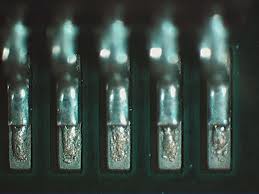Poor Wetting Issues
Issue Description: Poor solder wetting can result from a variety of issues. This defect is well known to most in the assembly industry. The solder appears to have flowed only part of the way onto pads or component leads. The solder can take on a grainy or dull appearance.
 1) Elimination of oxides on the surfaces being soldered is key to ensure good wetting.
1) Elimination of oxides on the surfaces being soldered is key to ensure good wetting.
Higher activity solder pastes typically give better wetting, especially when soldering to difficult surface finishes or oxidized surfaces. Surface finishes that are difficult to wet, especially after the first reflow, are immersion silver, immersion tin, and OSP.
Use of nitrogen during reflow can minimize oxides that build during the reflow cycle.
2) Low solder paste volume can result in insufficient wetting.
Modification of the stencil to provide higher solder paste volume can correct this issue.
Use of components with larger leads will compensate for low solder paste volume and help to complete the solder joint.
3) Adjustments to the reflow profile will optimize soldering temperatures in trouble spots.
Increasing soak time will help to equalize soldering temperatures and allow for good wetting of both the pads and component leads.
Increasing time above liquidus will help to allow for complete flow of the liquid solder before it begins to freeze.

